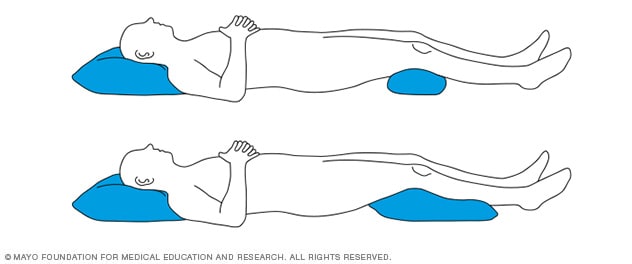
If you often struggle to fall asleep, it’s a good idea to try winding down before bed. That can include any way of relaxing the body, including reading a book or lying down quietly.
Some people find that having a warm bath before bed helps them to fall asleep faster, while others prefer writing a to-do list.
It’s important to keep to regular sleep hours, as this programs the brain and internal body clock to get used to a set routine, said the NHS.
The bedroom should be a sleep-friendly and relaxing environment. It should be dark, quiet, tidy, and kept at a temperature between 18 and 24 degrees Celsius.
1. Sleep on your side with a pillow between your knees

If lying flat on your back feels uncomfortable, try shifting over to your side:
- Allow your right or left shoulder to make contact with the mattress, along with the rest of that side of your body.
- Place a pillow between your knees.
- If there’s a gap between your waist and the mattress, consider using a small pillow there for added support.
Whether you use one pillow or opt for two, you should resist the urge to always sleep on the same side. Doing so many cause issues like muscle imbalance and even scoliosis.
How does this position help? Sleeping on your side alone won’t make you feel better. It’s using the pillow between your knees that’s the trick. The pillow will keep your hips, pelvis, and spine in better alignment.
2. Sleep on your side in the fetal position

If you have a herniated disc, you may want to try sleeping on your side curled in a fetal position:
- Lay on your back and then roll over gently onto your side.
- Tuck your knees toward your chest and gently curl your torso toward your knees.
- Remember to switch sides from time to time to prevent any imbalances.
How does this position help? Your discs are soft cushions between the vertebrae in your spine. Herniation happens when part of a disc pushes out of its normal space, causing nerve pain, weakness, and more. Curling your torso into a fetal position opens the space between vertebrae.
3. Sleep on your stomach with a pillow under your abdomen

You may have heard that sleeping on your stomach is actually bad for back pain. This is partly true because it may add stress to your neck.
But if you find yourself resting on your stomach, you don’t have to force another position. Instead:
- Place a pillow under your pelvis and lower abdomen to relieve some of the pressure off your back.
- Depending on how this position feels, you may or may not choose to use a pillow under your head.
How does this position help? People who have degenerative disc disease may benefit most from stomach sleeping with a pillow. It can relieve any stress that is placed on the space between your discs.
4. Sleep on your back with a pillow under your knees

For some people, sleeping on their back may be the best position to relieve back pain:
- Lay flat on your back.
- Place a pillow underneath your knees and keep your spine neutral. The pillow is important — it works to keep that curve in your lower back.
- You may also place a small, rolled up towel under the small of your back for added support.
How does this position help? When you sleep on your back, your weight is evenly distributed and spread across the widest area of your body. As a result, you place less strain on your pressure points. You’re also able to get better alignment of your spine and your internal organs.
5. Sleep on your back in a reclined position

Sleeping in a reclined position may benefit lower back pain, particularly in people with isthmic spondylolisthesis.
If significant relief is found from resting in a reclined chair, it may be worth investing in an adjustable bed that can be positioned accordingly.
6. Sleeping on the front with the head face down
Another reason sleeping on the front is considered bad is because the head is usually turned to one side. This twists the spine and places additional stress on the neck, shoulders, and back.
To avoid this, try lying face down. A small but firm pillow or tightly rolled-up towel can be used to prop up the forehead, allowing room to breathe. This should be done in addition to placing a pillow under the stomach.
To adopt this sleeping position, a person should:
- Get into bed and roll onto their front.
- Place a slim pillow underneath the abdomen and hips to raise the mid-section.
- Position a pillow or rolled-up towel under the forehead to create adequate breathing space between the mouth and mattress.
Don’t Forget to Follow us across our social channels to get the latest, on Facebook , Twitter .










